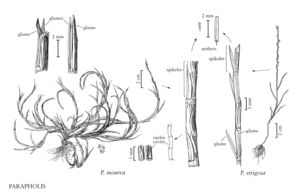Parapholis incurva
Culms 2-35 cm, erect to decumbent, smooth, glabrous, branching at any node. Sheaths of upper leaves strongly inflated, margins expanded, enclosing the lowest spikelets; ligules to 1.5 mm; blades 1-3(10) cm long, 1-3 mm wide, adaxial surfaces scabrid. Spikes 1-15 cm, solitary, curved and twisted, rigid, with 2-20 spikelets. Spikelets 4.5-7.5 mm, usually slightly longer than the internodes, more or less cleistogamous. Glumes lanceolate, acuminate, keels rarely slightly winged; anthers 0.5-1.3 mm. 2n = 32, 36, 38, 42.
Distribution
Md., N.J., N.C., Del., Tex., La., Calif., Mich., Ala., Va., Pa., Miss., Oreg.
Discussion
Parapholis incurva is established at various locations on the coasts of the contiguous United States. It grows in both poorly drained and well-drained disturbed soils, at and above the high tide mark. It tends to grow in more saline soils, and at lower elevations with respect to the tide, than P. strigosa.
Selected References
None.
